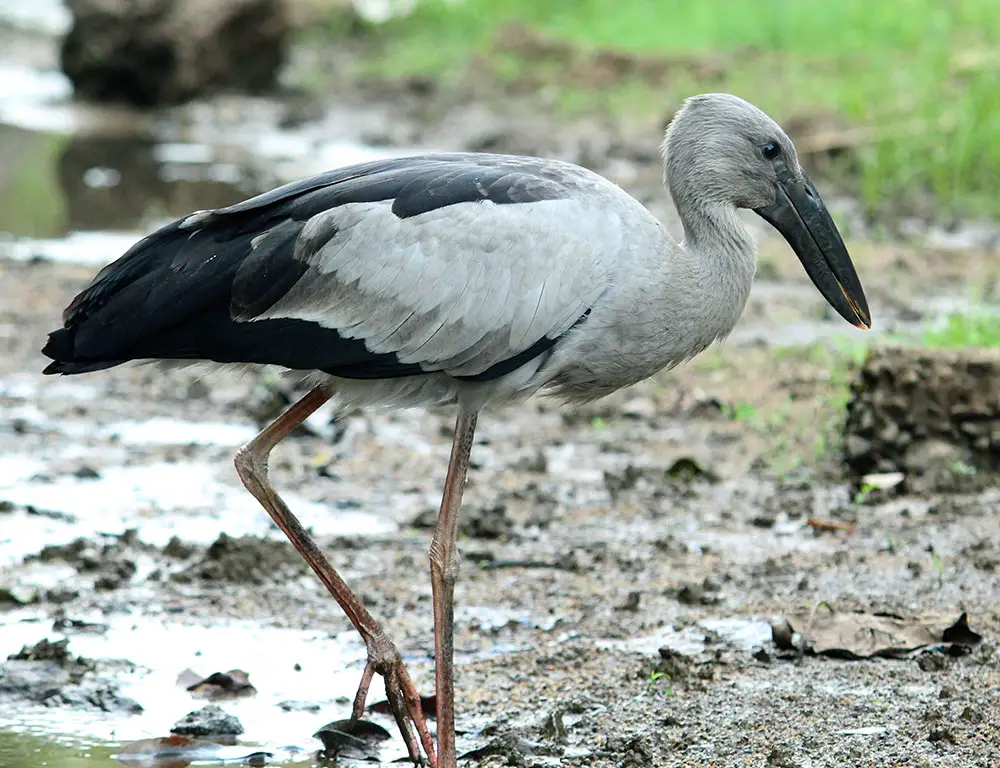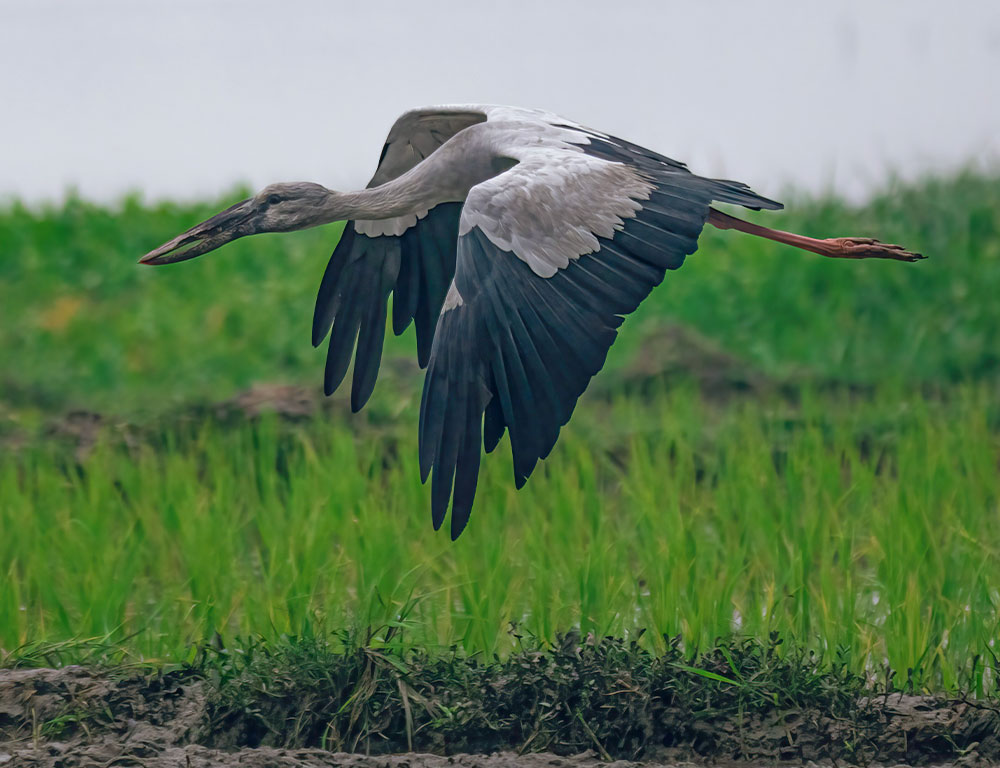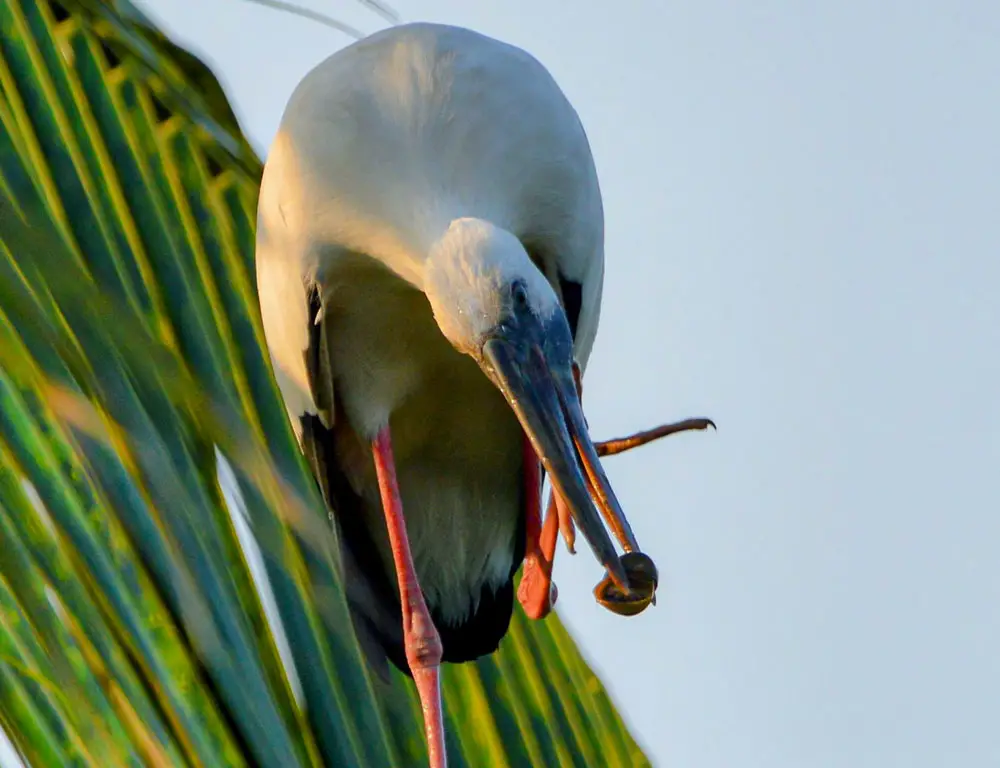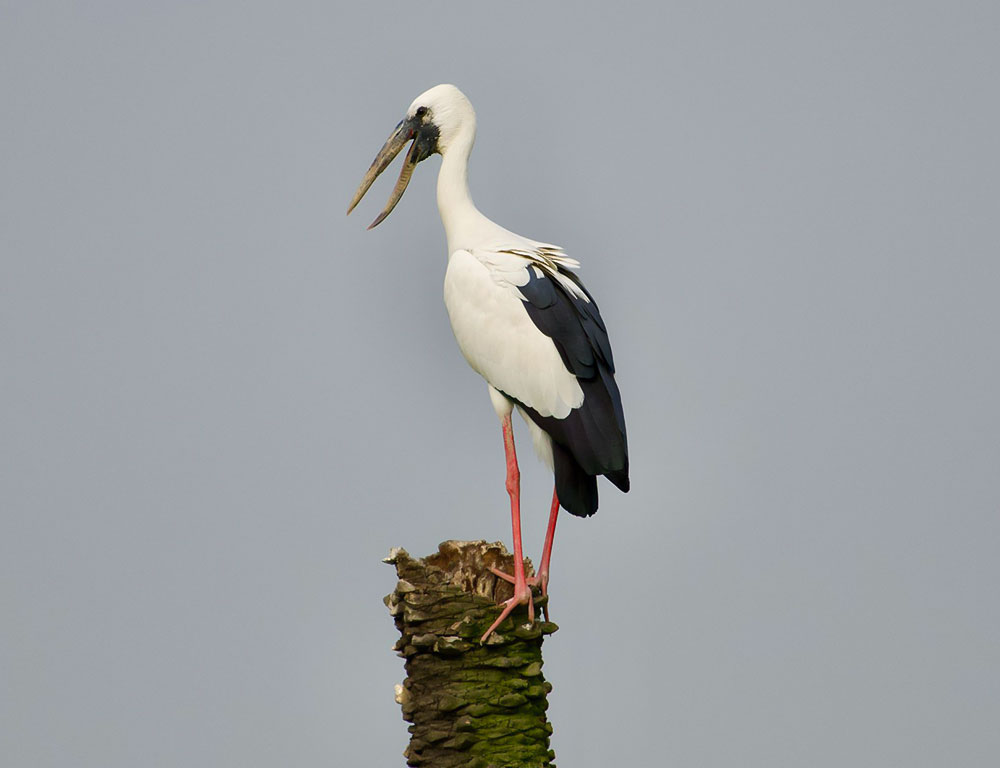The Asian Openbill is undoubtedly a bird worth knowing about. This stork species, scientifically known as Anastomus oscitans, has a unique beak perfect for its water snails and mollusks diet.
It’s not just the distinctive bill that sets it apart, though – this bird has many fascinating aspects.
When I first saw an Asian Openbill, I was struck by its elegance. Their long legs and sweeping wings make them seem almost otherworldly.
Native to Asia, they’re often found in the Indian subcontinent and Southeast Asia, where they can access their preferred wetland habitats.
Of course, one must mention their intriguing breeding habits to discuss these stunning creatures. The Asian Openbill breeds in colonies, building nests high up in trees near water bodies. Isn’t nature truly captivating?
Physical Characteristics of the Asian Openbill Stork

The Asian Openbill boasts several intriguing physical characteristics that set it apart from other stork species. Here’s a summary:
Distinctive Beak
The most notable feature of the Asian Openbill is its unique bill, which appears to have a gap or “open bill” in mature adults. This specialized beak is perfectly adapted for feeding on their favorite food – snails.
It’s not an aberration but rather a trait specific to this species, serving a unique purpose in their feeding behavior.
Size
Asian Openbills are moderately large birds, typically measuring 68 and 81 cm (27 and 32 inches) in length, with a wingspan ranging from 149 to 156 cm (59 and 61 inches). Their size gives them an impressive presence when soaring through the skies.
Plumage
Their plumage is generally pale grey and white, with some individuals exhibiting darker shades on their wings. These color variations provide excellent camouflage capabilities within their natural habitats of wetlands and rice fields.
Flight Pattern
When flying high above ground level, Asian Openbills stretch their necks fully forward while trailing their legs behind, creating an iconic sight often associated with storks worldwide. This flight pattern adds to their grace and distinguishes them in the air.
Habitat and Distribution of the Asian Openbill

The Asian Openbill is a fascinating bird with unique habitat preferences and a wide distribution range across Asia.
Here’s a summary of its habitat and distribution:
Habitat Preferences
Asian Openbills are typically found in wetland areas, favoring habitats near freshwater bodies such as rivers, lakes, marshes, and flooded fields. These areas provide ample opportunities for the bird to find its primary food source, snails.
Seasonal Movement
During the breeding season, which typically occurs between November and March, Asian Openbills tend to move towards drier areas. However, during non-breeding seasons, they migrate back to water-rich regions.
Geographical Distribution
The Asian Openbill has an extensive distribution range across Asia, from India through Southeast Asia to Indonesia. Countries with high concentrations of these birds include Bangladesh, Cambodia, India, Laos, and Thailand.
Occasional Sightings Outside Native Range
Although native to Asia, the Asian Openbill has been occasionally sighted outside its usual territory. Rare sightings have been reported in Ukraine and Japan, indicating sporadic movements beyond their typical range.
Diet and Feeding Behavior of the Asian Openbill

The Asian openbills’ diet and feeding behavior are fascinating and showcase their adaptability to their environment. Here’s a summary:
Primary Diet
The Asian Openbill’s diet primarily consists of aquatic mollusks, with a particular fondness for apple snails. They use their uniquely shaped bills to extract snails from their shells precisely, targeting the weakest points to access the nutritious contents.
Feeding Behavior
These birds are not indiscriminate feeders; they have a keen sense of locating food sources in shallow waters. Working in groups, they wade through wetlands and rice fields to find their preferred prey.
They also employ a “bill-gaping” technique underwater to catch smaller prey such as insects and small fish.
Typical Meal Composition
An average meal for an Asian Openbill may consist primarily of apple snails, supplemented with small mollusks, insects, and fish. This varied diet ensures they obtain the necessary nutrients for survival.
Daily Food Requirements
Due to the low nutritional value of snails, Asian Openbills require large quantities of food daily, consuming up to 250 grams per day. This highlights the importance of constant foraging to meet their energy needs.
Conservation Status of the Asian Openbill

The conservation status of the Asian Openbill, as assessed by the International Union for Conservation of Nature (IUCN), currently stands as “least concern.” This designation indicates that the species is not facing an immediate threat of extinction.
However, it’s essential to remain vigilant and proactive in safeguarding their populations due to the various ongoing challenges they encounter.
Threats
- Habitat Loss: The primary threat to Asian Openbills is habitat loss due to urbanization and agricultural expansion. Wetlands and rice fields, crucial bird habitats, are increasingly being converted for human use.
- Hunting: While hunting for food and trade poses a threat, it’s not as severe as habitat loss. Nevertheless, it contributes to the pressures faced by local populations.
- Pesticide Exposure: Asian Openbills are exposed to pesticides used in rice fields, where they often feed. While this threat is of medium impact, it could have long-term implications if not managed effectively.
Conservation Efforts
In various regions across Asia, local communities and conservation organizations are implementing measures to protect the Asian Openbill:
- Traditional farming practices that maintain suitable bird habitats are encouraged in India and Sri Lanka.
- Thailand has established protected areas that preserve nesting sites, contributing to species conservation.
- Range countries are adopting bird-friendly land management policies to mitigate habitat loss and support healthy populations.
Conclusion
The exploration of the Asian Openbill has illuminated its unique adaptation to its habitat, showcasing nature’s ingenuity. Spanning across India, Sri Lanka, and Southeast Asia, these birds exhibit specialized feeding behaviors, primarily consuming snails.
Their breeding season from November to March underscores their life cycle’s intricacies. As we unravel their lifestyle, we appreciate how their distinctive features serve essential purposes in their survival.
The Asian Openbill exemplifies nature’s evolutionary brilliance, demonstrating the efficiency of adaptations in securing sustenance. It reminds us of our responsibility to preserve biodiversity by respecting wildlife habitats.
Through understanding and conservation efforts, we ensure the enduring existence of remarkable species like the Asian Openbill for generations to come. This journey through their world has been captivating, offering profound insights into the wonders of nature.